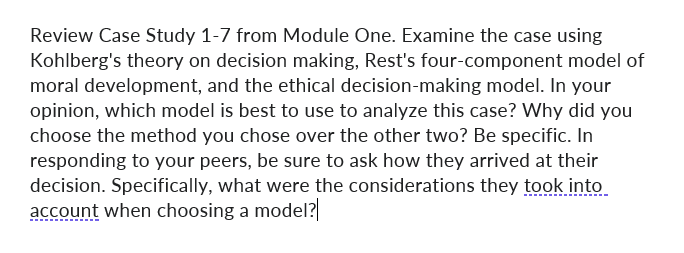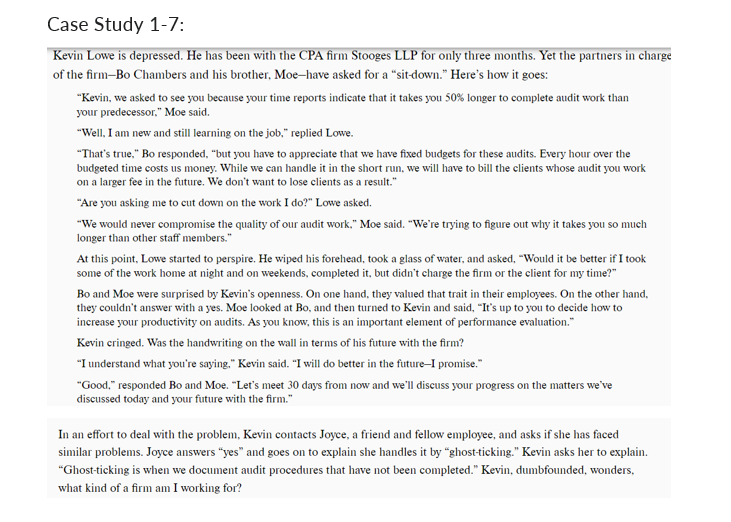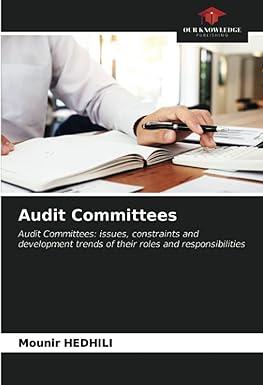Answered step by step
Verified Expert Solution
Question
1 Approved Answer
Review Case Study 1-7 from Module One. Examine the case using Kohlberg's theory on decision making, Rest's four-component model of moral development, and the ethical

 Review Case Study 1-7 from Module One. Examine the case using Kohlberg's theory on decision making, Rest's four-component model of moral development, and the ethical decision-making model. In your opinion, which model is best to use to analyze this case? Why did you choose the method you chose over the other two? Be specific. In responding to your peers, be sure to ask how they arrived at their decision. Specifically, what were the considerations they took into account when choosing a model? Kevin Lowe is depressed. He has been with the CPA firm Stooges LLP for only three months. Yet the partners in chare of the firm-Bo Chambers and his brother, Moe-have asked for a "sit-down." Here's how it goes: "Kevin, we asked to see you because your time reports indicate that it takes you 50% longer to complete audit work than your predecessor," Moe said. "Well, I am new and still learning on the job," replied Lowe. "That's true," Bo responded, "but you have to appreciate that we have fixed budgets for these audits. Every hour over the budgeted time costs us money. While we can handle it in the short run, we will have to bill the clients whose audit you work on a larger fee in the future. We don't want to lose clients as a result." "Are you asking me to cut down on the work I do?" Lowe asked. "We would never compromise the quality of our audit work," Moe said. "We're trying to figure out why it takes you so much longer than other staff members." At this point, Lowe started to perspire. He wiped his forehead, took a glass of water, and asked, "Would it be better if I took some of the work home at night and on weekends, completed it, but didn't charge the firm or the client for my time?" Bo and Moe were surprised by Kevin's openness. On one hand, they valued that trait in their employees. On the other hand. they couldn't answer with a yes. Moe looked at Bo, and then turned to Kevin and said, "It's up to you to decide how to increase your productivity on audits. As you know, this is an important element of performance evaluation." Kevin cringed. Was the handwriting on the wall in terms of his future with the firm? "I understand what you're saying," Kevin said. "I will do better in the future-I promise," "Good," responded Bo and Moe. "Let's meet 30 days from now and we'll discuss your progress on the matters we've discussed today and your future with the firm." In an effort to deal with the problem, Kevin contacts Joyce, a friend and fellow employee, and asks if she has faced similar problems. Joyce answers "yes" and goes on to explain she handles it by "ghost-ticking." Kevin asks her to explain. "Ghost-ticking is when we document audit procedures that have not been completed." Kevin, dumbfounded, wonders, what kind of a firm am I working for
Review Case Study 1-7 from Module One. Examine the case using Kohlberg's theory on decision making, Rest's four-component model of moral development, and the ethical decision-making model. In your opinion, which model is best to use to analyze this case? Why did you choose the method you chose over the other two? Be specific. In responding to your peers, be sure to ask how they arrived at their decision. Specifically, what were the considerations they took into account when choosing a model? Kevin Lowe is depressed. He has been with the CPA firm Stooges LLP for only three months. Yet the partners in chare of the firm-Bo Chambers and his brother, Moe-have asked for a "sit-down." Here's how it goes: "Kevin, we asked to see you because your time reports indicate that it takes you 50% longer to complete audit work than your predecessor," Moe said. "Well, I am new and still learning on the job," replied Lowe. "That's true," Bo responded, "but you have to appreciate that we have fixed budgets for these audits. Every hour over the budgeted time costs us money. While we can handle it in the short run, we will have to bill the clients whose audit you work on a larger fee in the future. We don't want to lose clients as a result." "Are you asking me to cut down on the work I do?" Lowe asked. "We would never compromise the quality of our audit work," Moe said. "We're trying to figure out why it takes you so much longer than other staff members." At this point, Lowe started to perspire. He wiped his forehead, took a glass of water, and asked, "Would it be better if I took some of the work home at night and on weekends, completed it, but didn't charge the firm or the client for my time?" Bo and Moe were surprised by Kevin's openness. On one hand, they valued that trait in their employees. On the other hand. they couldn't answer with a yes. Moe looked at Bo, and then turned to Kevin and said, "It's up to you to decide how to increase your productivity on audits. As you know, this is an important element of performance evaluation." Kevin cringed. Was the handwriting on the wall in terms of his future with the firm? "I understand what you're saying," Kevin said. "I will do better in the future-I promise," "Good," responded Bo and Moe. "Let's meet 30 days from now and we'll discuss your progress on the matters we've discussed today and your future with the firm." In an effort to deal with the problem, Kevin contacts Joyce, a friend and fellow employee, and asks if she has faced similar problems. Joyce answers "yes" and goes on to explain she handles it by "ghost-ticking." Kevin asks her to explain. "Ghost-ticking is when we document audit procedures that have not been completed." Kevin, dumbfounded, wonders, what kind of a firm am I working for Step by Step Solution
There are 3 Steps involved in it
Step: 1

Get Instant Access to Expert-Tailored Solutions
See step-by-step solutions with expert insights and AI powered tools for academic success
Step: 2

Step: 3

Ace Your Homework with AI
Get the answers you need in no time with our AI-driven, step-by-step assistance
Get Started


